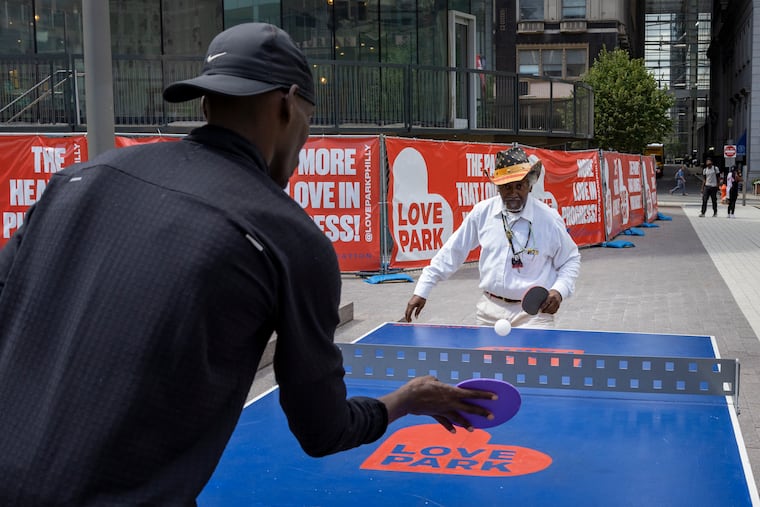Forget the spin about pickleball. Table tennis remains a timeless and enduring sport.
What returning to the unsung sport after 15 years taught me about its many virtues.

Chances are that you’ve heard of pickleball and can’t get enough. Or, perhaps, you’re irritated by that one uncle who gives an unsolicited St. Crispin’s Day-type speech about “dinks in the kitchen,” or how it’s the fastest-growing sport in the country, with nearly nine million players in 2022, according to the Sports and Fitness Industry Association.
If you don’t love pickleball, then table tennis — a joyous, timeless sport from which anyone can benefit — deserves your paddle’s consideration.
Any half-serious table tennis player will tell you the facts. It’s enormously popular around the world — an estimated 350 million people watched table tennis at the 2020 Tokyo Olympics. It’s a perennial Olympic sport. It’s also a central reason the Cold War thawed, due to improved relations with China through “ping-pong diplomacy.”
In postwar 1950s America, when the development of suburban homes doubled, pingpong was peddled as quintessential urban leisure in the comfort of one’s own home. That newfound ubiquity ended up doing the sport a disservice, however, casting it as light refreshment to the main course that is tennis. Since then, the sport has been swimming upstream against cultural scions left by Forrest Gump and collegiate beer pong.
What table tennis requires, it seems, is a cosmetic makeover to rebrand the quickfire joy and community it fosters.
As a boy, I was transfixed by Swedish player Jan-Ove Waldner, nicknamed “the Mozart of table tennis.” One play stands out. In 2001, he played a young Timo Boll, the German lefty known for his speedy backhand loop. Waldner served it long to Boll’s forehand, and then strangely half-chopped it to Boll’s backhand. This was the kind of shot Boll feasted on, the bread-and-butter shot that a decade later catapulted him to No. 1 in the International Table Tennis Federation rankings.
But as Boll wound up and struck a loop with filigree precision, Waldner didn’t backpedal or brace himself for a return. Instead, he started calmly walking away, as though he was walking his dachshund down the block. And then by some small miracle — and this was Waldner’s genius — he nonchalantly lifted his paddle to block the ball down the line for a lightning-fast winner.
I grew up in Mount Airy, where the table tennis community was small, if not extinct. The closest clubs and tournaments usually were over the bridge in South Jersey or an hour away in West Chester.
In middle school, at the height of my playing days, I became a table tennis evangelist. I priggishly declaimed to anyone who would deign to listen that pingpong is a basement recreation, whereas table tennis is the true sport. My parents, amid nervous chuckles, learned to encourage my idiosyncratic love. To impress dinner guests, my stepfather would place Werther’s caramel candies on the corners of the table and I’d knock them off one by one, like a party trick.
The more monastic I became about the craft, the more friends and strangers teased my predilection. After all, real sport requires physical contact, or, at the very least, a venue larger than a basement. According to the 2010 book, Everything You Know Is Pong by Roger Bennett and Eli Horowitz, pingpong resists simple anatomical dominance yet remains intensely physical. “Utterly egalitarian, ping pong has a home at every stage of our lives,” the authors wrote.
Having to defend the virtues of table tennis as a teenager was exhausting. As a result, I shunted my ardor to the sidelines. It wasn’t until a graduate school friend told me 15 years later about PingPod — a glass-walled, 24/7 automated facility that opened one of its 14 locations in Old City last year — that I resumed my love affair.
Having to defend the virtues of table tennis as a teenager was exhausting.
Since my return to the sport, I have been pleasantly surprised by the number and quality of clubs in the area. In addition to PingPod, there’s the ever-popular Trolley Car Table Tennis Club in East Falls, the newly established Club28 in Port Richmond that offers badminton, and the Upper Darby Table Tennis Club. For those who’d rather play while swilling beer, there is SPIN Philadelphia, which is owned by Academy Award-winning actress Susan Sarandon.
Because of its global influence, table tennis lures an eclectic community. It cuts across race and ethnicity, gender, sexuality, and age. Not to mention the various health benefits, particularly for the brain. As pickleball-related injuries surge, a brain-imaging study from Japan equates pingpong to “aerobic chess,” as only 10 minutes increases activity in the prefrontal cortex and cerebellum — those parts responsible for problem-solving and motor control.
» READ MORE: Pickleball is so annoying. And it’s taking over tennis courts. | Jenice Armstrong
Then there’s PingPongParkinson. Founded at the Westchester Table Tennis Center in New York, it’s an organization with a new chapter in Philadelphia that uses the salutary side effects of table tennis to aid in halting the progression of the disease.
“There’s strength and rhythm and coordination and balance all involved,” said David Russell, senior director of clinical research at the Institute for Neurodegenerative Disorders, in a testimonial video. “So it is an intriguing idea that maybe pingpong would be a particularly productive exercise for Parkinson’s disease.”
When asked in his 80s what the secret to his longevity was, Tropic of Cancer writer Henry Miller said, “The purity of my soul, playing Ping-Pong, and, above all, love!”
Ultimately, it’s just semantics. Table tennis is pingpong — and both are as timeless as love.
Ezra Solway is a poet, journalist, and pingpong maven. A Pushcart Prize nominee, he earned a master of fine arts from Temple University.